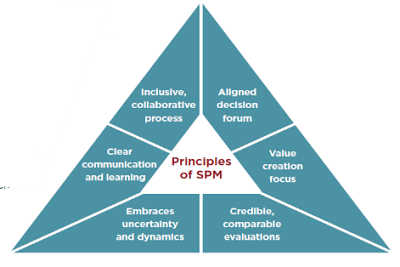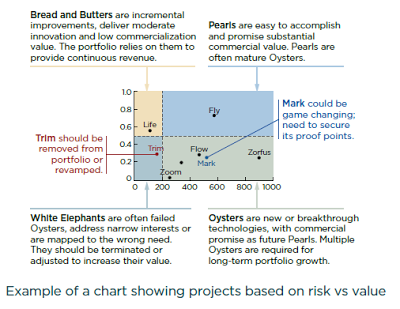BEI
The 6 Principles of Strategic Portfolio Management: Embracing Uncertainty & Dynamics

By: Don Creswell,
Co-founder & Vice President, SmartOrg Inc.
Co-founder & Vice President, SmartOrg Inc.
In the business world, we strive to make sound decisions. We
want to be confident that we have done all of our research and that by the time
we are launching a new product, we have addressed every aspect of it to ensure
its success. During the product development cycle, things change that make
updating and tracking our assessments a vital part of the process. It requires
that we address the uncertainties that arise. Whether we are experiencing
fluctuations in our market, there is instability in the economy, or consumer
trends are changing before our product reaches them, we must carefully examine
all of the uncertainties. By embracing uncertainty rather than fighting against
it, we put ourselves in a better position to achieve successful outcomes. This
is what we mean when we refer to dynamics.
want to be confident that we have done all of our research and that by the time
we are launching a new product, we have addressed every aspect of it to ensure
its success. During the product development cycle, things change that make
updating and tracking our assessments a vital part of the process. It requires
that we address the uncertainties that arise. Whether we are experiencing
fluctuations in our market, there is instability in the economy, or consumer
trends are changing before our product reaches them, we must carefully examine
all of the uncertainties. By embracing uncertainty rather than fighting against
it, we put ourselves in a better position to achieve successful outcomes. This
is what we mean when we refer to dynamics.
A Case Study
A Fortune 100 company acquired several smaller companies
that each had good products in the market, but there was an apparent lack of
new concepts in the R&D pipeline. The company established a new R&D lab
with the goal of researching their way to become a world-class firm. Since the
lab was new and the technical areas they were researching were cutting edge,
they picked easy targets to fast-track their way onto the map. But was that
sustainable? Was the lab on track? Would that method generate the hits they
needed to fill the pipeline?
that each had good products in the market, but there was an apparent lack of
new concepts in the R&D pipeline. The company established a new R&D lab
with the goal of researching their way to become a world-class firm. Since the
lab was new and the technical areas they were researching were cutting edge,
they picked easy targets to fast-track their way onto the map. But was that
sustainable? Was the lab on track? Would that method generate the hits they
needed to fill the pipeline?
A quantitative evaluation of the lab's procedures revealed
they had a lab full of 'white elephants' (refer to chart) and
'bread-and-butter' product projects.' They lacked 'oysters' to give them a
chance to create breakthrough products ('pearls'). Given this knowledge, they
developed a strategy to identify additional valuable, though risky targets,
redirected or killed the white elephants and re-balanced their portfolio to
improve the overall odds of winning.
they had a lab full of 'white elephants' (refer to chart) and
'bread-and-butter' product projects.' They lacked 'oysters' to give them a
chance to create breakthrough products ('pearls'). Given this knowledge, they
developed a strategy to identify additional valuable, though risky targets,
redirected or killed the white elephants and re-balanced their portfolio to
improve the overall odds of winning.
Dangers of
Deterministic Thinking
Deterministic Thinking
In mathematics and physics, a deterministic system
is a system in which no randomness is involved in the development of future
states of the system. A deterministic model will thus always produce
the same output from a given starting condition or initial state.
is a system in which no randomness is involved in the development of future
states of the system. A deterministic model will thus always produce
the same output from a given starting condition or initial state.
When we allow deterministic thinking and aversion to risk to
drive the quest for certainty, assumptions tend to be made to defend a position
and the ability to confirm information is suppressed. This leads to assumptions
comingling discussions about knowledge, commitments and aspirations into point
estimates.
drive the quest for certainty, assumptions tend to be made to defend a position
and the ability to confirm information is suppressed. This leads to assumptions
comingling discussions about knowledge, commitments and aspirations into point
estimates.
However, when we embrace uncertainty and dynamics, and
address the uncertainties explicitly over time, we create an opportunity for
robust thinking about upsides, downsides and options. There is more of a
willingness to take prudent calculated risks. Discussions around uncertain
factors area separated from discussions about commitments and aspirations.
Information is represented in terms of ranges and probabilities, with
supporting rationales for the assessments.
address the uncertainties explicitly over time, we create an opportunity for
robust thinking about upsides, downsides and options. There is more of a
willingness to take prudent calculated risks. Discussions around uncertain
factors area separated from discussions about commitments and aspirations.
Information is represented in terms of ranges and probabilities, with
supporting rationales for the assessments.
Even the best researched decision making can result in
failure. No matter how you try to control uncertainty, things do not always
work out. If you are intolerant to uncertainty, you may create unnecessary
stress and anxiety for yourself and your colleagues. If, instead, you recognize
that uncertainty is a normal condition, factor it into your analyses and adapt
as changes arise, you will find that you are in a better position to make and defend
your decisions.
failure. No matter how you try to control uncertainty, things do not always
work out. If you are intolerant to uncertainty, you may create unnecessary
stress and anxiety for yourself and your colleagues. If, instead, you recognize
that uncertainty is a normal condition, factor it into your analyses and adapt
as changes arise, you will find that you are in a better position to make and defend
your decisions.
This is the fifth in a
series of blogs on The Six Principles of Strategic Portfolio Management.
Subsequent blogs will address each of the six principles in detail. For further
information about SPM processes and decision-support software, visit www.smartorg.com or contact info@smartorg.com
series of blogs on The Six Principles of Strategic Portfolio Management.
Subsequent blogs will address each of the six principles in detail. For further
information about SPM processes and decision-support software, visit www.smartorg.com or contact info@smartorg.com






